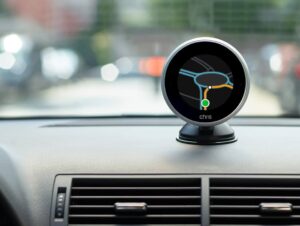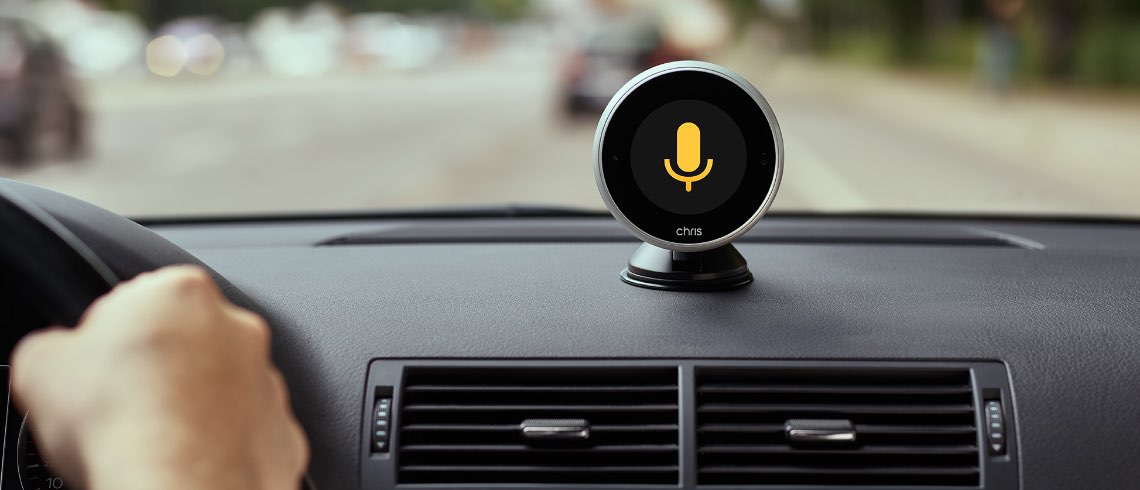Is it possible to offer drivers an intuitive, interactive, and feature-rich personal assistant without creating potentially dangerous distractions or without requiring consumers to purchase the latest car to get the latest innovations from smartphone manufacturers? For German Autolabs, a young startup from Berlin, the answer is a resounding “yes!” thanks to Chris, a device that takes an entirely different approach to assist drivers compared to traditional smartphones and the user interfaces that are now common in mainstream vehicles. The company decided to use an STM32F769 microcontroller (MCU) and five ST MEMS (Micro Electro Mechanical Systems) microphones, the MP34DT05-A, to go from an innovative idea to a product available on its website for about €299,99. We thus decided to sit down with Daniel Mieves, in charge of Marketing, and Heiko Panther, responsible for Embedded Development, at German Autolabs, to better understand the philosophy and engineering behind Chris.
[pretty-callout align=”right”]Fun Facts
- Chris first launched as a Kickstarter campaign.
- The project gathered the support of 1,451 backers that pledged a total of €278,720.
- All backers received their orders.
- German Autolabs held demos at IFA 2018 and CES 2019.
Seeing Chris, the Secret of its GUI and Performance
Chris stands out because of its small form factor (3.5″ x 3.5″ x 1.7″ / 9 cm x 9 c, x 4.4 cm) thanks to its 2.1″ LCD display that challenges the notion that a bigger device is necessarily better. German Autolabs can offer an experience that is a lot less distracting because it manages to provide a reliable user interface that doesn’t require touching a screen or looking at a program to make sure it understood a particular command. For instance, Chris drastically optimizes navigation to display only the shapes and diagrams that help the driver navigate without all the clutter and inefficiencies of some of the latest mapping systems. Despite its minimalistic interface, Chris offers all the features available on smartphones or in-car systems, from messaging to music, call, voice assistant, and navigation, among others.
To avoid any potential distractions, the company had to develop a perfect, fast and efficient graphical user interface, which is one of the reasons behind their choice to use an STM32F769. The microcontroller embarks an LCD-TFT controller that takes advantage of our Chrom-ART Accelerator, which doubles the graphical computational throughput compared to an MCU without the engine. As Daniel and Heiko explained:
“By using ChromART and the TouchGFX framework, we were able to display a beautiful and powerful GUI without any negative impact on performance. Additionally, we used the MCU’s Flexible Memory Controller (FMC) to communicate with an external and a cost-effective SDRAM to ensure that our fast graphical interface would never become a performance hog.The flexibility of the STM32F769 also enabled Chris to integrate five MEMS microphones and build a voice recognition system that shines thanks to its outstanding performance, even in noisy environments.
Talking to Chris, Implementing Beamforming and Wake-Up-Word

German Autolabs first used five ST MEMS microphones because we offer a development platform with algorithms and software tools that the company was able to use to implement complex features like beamforming and wake-up expression. The former processes the audio signal from all microphones to better reject ambient noise and capture the driver’s voice. The system uses two beamformers, each made of two mics, while one ST MEMS microphone serves as a standard omnidirectional device. The second feature, a wake-up expression, can be particularly tricky on embedded systems because continually listening to a command can demand a lot of resources. Chris thus uses our algorithms to optimize performance, and the company worked with our partner to define and implement a custom expression (“Hey Chris”) without necessitating a lot of time and development hours.
Heiko and Daniel also told us that they chose our solutions because of how well they worked together.
“By using ST’s microphones and STM32F769, we were able to take advantage of the DFSDM (Digital Filter for Sigma-Delta Modulator) interface of the microcontroller, which allowed us to efficiently route the signal from multiple microphones without introducing significant noise and without drastically increasing the power consumption.Engineers no longer have to route an analog signal across the board, potentially introducing interference. The analog to digital conversion happens inside the mic that provides a PDM output data format directly to the MCU’s DFSDM that uses only digital filters. The company also used the MCU’s flexible DMA (Direct Access Memory) support and its numerous I/Os, which made the pin configuration easier and enabled them to use three SPI buses, five UART interfaces, and three I2C buses, making software development a lot simpler.
Will You Help Yourself Drive Better?

And Chris stands apart from the rest of the industry with an impressive software solution that ensures the system can offer a lot of offline features. Users do have to install an app on their smartphone and Chris uses the telephone to move some computations away from the windshield module. By using a combination of Bluetooth and Bluetooth LE, the system can quickly search through the music library on the phone, read and send messages, or route calls. The power of Chris is that the user is oblivious to all this and just benefits from a much better experience. An infrared camera even enables drivers to control Chris by merely using gestures. In other words, thanks to ST’s MCU and MEMS microphones, German Autolabs developed such an intuitive and impressive product that there are no more excuses for taking our eyes off the road.
- Learn more about Chris
- Check out our STM32F769
- See our ST MEMS microphones
